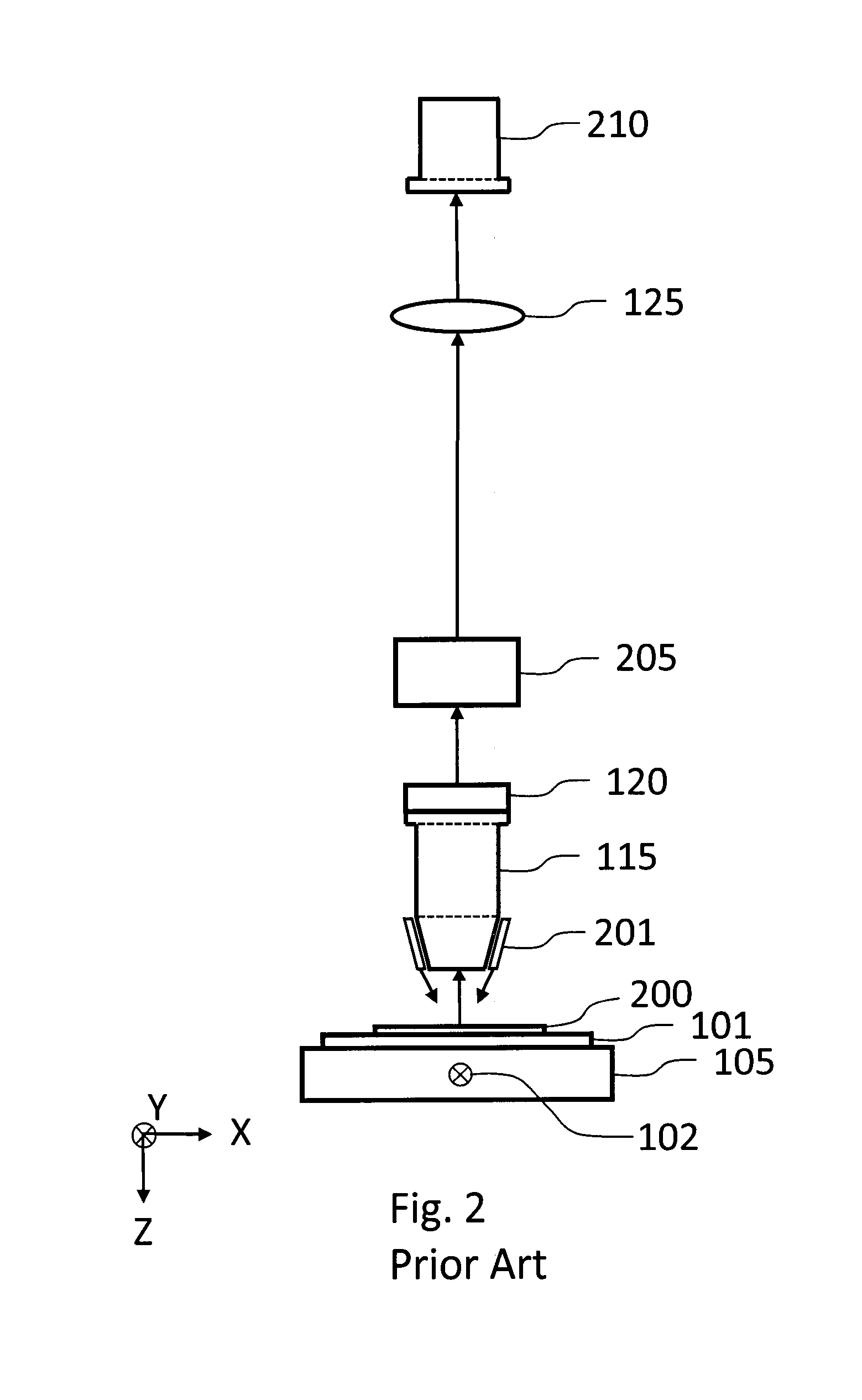Slide scanner with dynamic focus and specimen tilt and method of operation
a scanning machine and dynamic focus technology, applied in the field of microscopic imaging of large specimens, can solve the problems of increased signal/noise and amplitude, increased tiling artifact chances, and inability to achieve proper focus across the whole width of the strip, so as to prevent the effect of tiling mismatch at the edges
- Summary
- Abstract
- Description
- Claims
- Application Information
AI Technical Summary
Benefits of technology
Problems solved by technology
Method used
Image
Examples
first embodiment
[0044]FIG. 4 shows a schematic representation of a brightfield scanner that performs simultaneous focus and specimen tilt adjustments during scanning that is this invention. A large tissue specimen 400 (or other specimen to be imaged) is mounted on microscope slide 101 which is held by slide mount 401. Slide mount 401 is supported on the left by hinge 420 (which rotates about the Y axis) and on the right by piezoelectric positioner 402, which moves in the Z direction. Slide mount 401 is open in the centre (like a picture frame) to allow the microscope slide to be illuminated from below by illumination source 110. Light passing through the specimen is collected by infinity-corrected microscope objective 115 which is focused on the specimen by piezo positioner 120, controlled by computer 430 through control cable 433. The computer 430 can be any central processing unit. The microscope objective 115 and tube lens 125 form a real image of the specimen on linear detector array 130. Data ...
third embodiment
[0050]In FIG. 5, if TDI detector array 210 is replaced by an ordinary two-dimensional (2D) detector array (not a TDI array), then Moving Specimen Image Averaging can be used to acquire fluorescence image strips as described above. This is this invention. Both focus position and tilt can be measured by performing a Z-scan at several Y positions along each strip before scanning, with the specimen tilt set at zero.
[0051]With the detector parallel to the scan plane, a Z-scan is performed by moving the microscope objective in the Z direction using the piezo positioner to a series of equally-spaced positions in Z, while storing the resulting series of 2D images, each of which has the same width as the scan strip, using the 2D detector (or alternatively, a Z-scan can be performed by moving either the detector or the specimen in the Z direction). This results in a 3D image stack at each Y position, and if the detector used as an example in the description above is used, this image stack con...
fourth embodiment
[0058]Dynamic focus and dynamic tilt as described in this fourth embodiment will also be useful for second and third harmonic generation microscopy, and coherent anti-Stokes Raman scattering microscopy (CARS microscopy), in both scanning microscope and scanning macroscope configurations. Dynamic focus and dynamic tilt will also be useful in a scanning laser microscope used for two-photon or multi-photon fluorescence, and second and third harmonic generation microscopy.
[0059]When used for two-photon or multi-photon fluorescence, either a descanned detector where emission light is descanned by the scanning mirror (as shown in FIG. 8) or beam scanner (as shown in FIG. 9) or a non-descanned detector (where light is not descanned by the scanning mirror) can be used. In one arrangement, a non-descanned detector is placed below the microscope slide to receive fluorescence transmitted through the slide. A description of non-descanned detection is shown in “Multi-Photon Molecular Excitation ...
PUM
 Login to View More
Login to View More Abstract
Description
Claims
Application Information
 Login to View More
Login to View More - R&D
- Intellectual Property
- Life Sciences
- Materials
- Tech Scout
- Unparalleled Data Quality
- Higher Quality Content
- 60% Fewer Hallucinations
Browse by: Latest US Patents, China's latest patents, Technical Efficacy Thesaurus, Application Domain, Technology Topic, Popular Technical Reports.
© 2025 PatSnap. All rights reserved.Legal|Privacy policy|Modern Slavery Act Transparency Statement|Sitemap|About US| Contact US: help@patsnap.com



